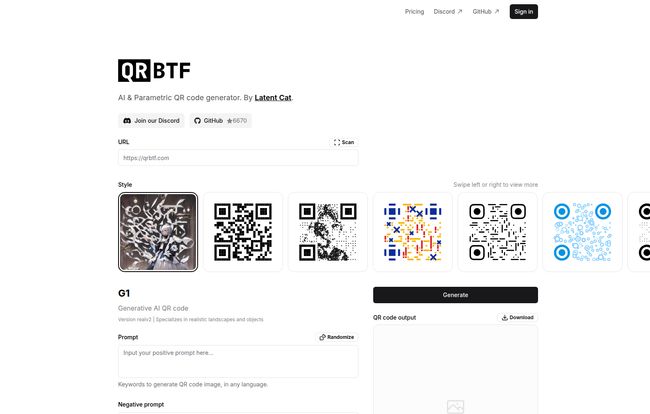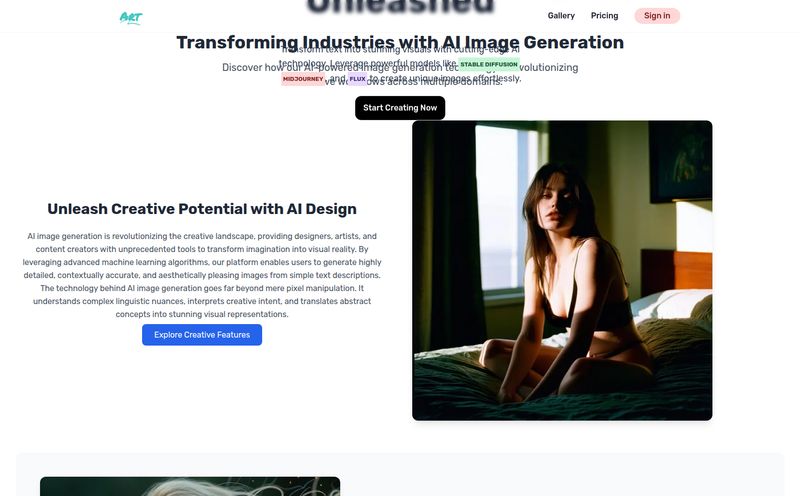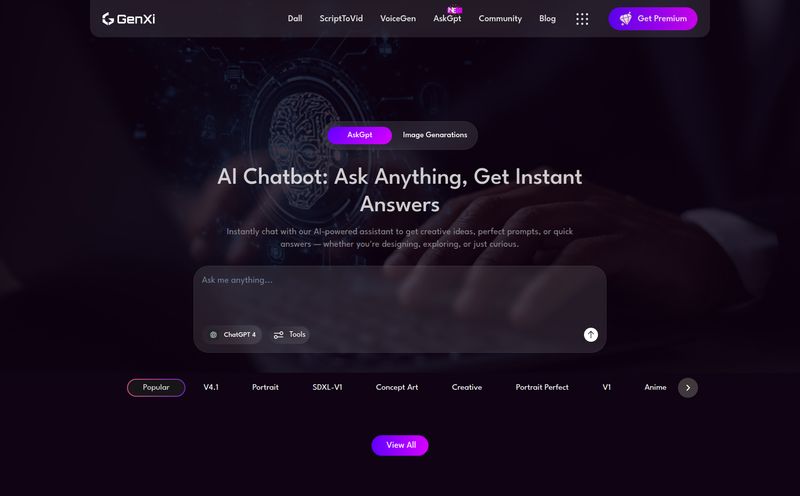QR codes are incredibly useful. Since the great restaurant menu apocalypse of 2020, they've become as common as pigeons in a city park. We scan them for everything—from paying for coffee to getting on a plane. But aesthetically? Most of them are just… ugly. A blocky, black-and-white mess that screams “I am a utility, not a thing of beauty.”
For years, marketers and designers have tried to pretty them up. We've put logos in the middle, rounded the corners, changed the colors. Cute, but it always felt like putting lipstick on a modem. The fundamental blockiness remained. What if you could do more? What if a QR code could be a piece of art that’s also scannable?
Well, I've been playing around with a tool that does just that, and it's kind of blown my mind. It's called QRBTF, and it’s an AI QR code generator that feels less like a utility and more like a creative partner.
So, What on Earth is QRBTF?
At its core, QRBTF (a catchy name, I know) is a web-based platform for creating QR codes. But that's where the similarities to your standard generator end. Built by a team called Latent Cat, QRBTF offers two distinct ways to create your codes, and one of them is pure magic.
It’s not just about changing colors. This tool uses AI to intelligently weave intricate images and styles into the data pattern of the QR code itself. The result is something that can look like a detailed painting, a realistic landscape, or an abstract design, but still points your phone’s camera right to the URL you intended. They even make the bold claim on their site of being the “world’s first AI-generated QR code,” which, if true, is a pretty cool piece of internet history.
The Two Flavors of QRBTF: Parametric vs. AI
When you land on the site, you're essentially given two paths. Choosing the right one depends on what you need.
Parametric QR Codes: The Solid, Stylish, and Free Foundation
First up is the parametric generator. This is the more traditional—but still very powerful—side of QRBTF. It lets you create stylized codes using a bunch of pre-set designs. You can make them round, add liquid-like effects, or use various other cool patterns. The best part? This entire parametric tool is free. Forever. It’s open source, supports SVG for high-quality scaling, and doesn’t even require a backend to run. For developers who want to integrate custom QR codes or small businesses needing something a bit jazzier than the default, this is an absolute gift.
AI QR Codes: This is Where the Fun Begins
And then there’s the AI generator. This is the main event. It’s the reason you’re probably reading this. It works similarly to AI image generators you might have heard of, like Midjourney or DALL-E. You give it a URL, and then you give it a prompt. You literally describe the image you want to see embedded in your QR code. “A majestic lion on the Serengeti,” “a cyberpunk city at night,” “a watercolor painting of a bouquet of flowers.”
The AI then gets to work, blending your artistic vision with the functional data points of the QR code. It’s like teaching a QR code to dream.
Getting My Hands Dirty: A Walkthrough of the Creative Process
Of course, I couldn't just write about it. I had to dive in. My mission: create a QR code for a fictional coffee shop's website that actually looked like a cup of coffee. I plugged in my URL and wrote my prompt: "A cinematic, top-down view of a steaming cup of black coffee in a ceramic mug, intricate latte art."Then you get to the controls. This is where you go from a casual user to an artist. There are several sliders:
- Control Strength: This is the big one. It determines how much the AI prioritizes the QR code's scannability versus the prompt's artistry. Too low, and you get a pretty picture that your phone can't read. Too high, and the QR code pattern starts to overpower the image. The sweet spot, as they recommend, is between 0.8 and 1.15.
- Restoration Rate: A finer tuning tool that helps the AI bring out more details from your prompt.
- Correction Level: This is a standard QR code feature, but it's super important here. Think of it as a built-in backup plan. A higher correction level (like H - 30%) builds more redundancy into the code. This means more of the image can be covered or artistically altered before it becomes unreadable. The trade-off? The QR code's base pattern becomes a bit denser and more visible.
My first attempt was... interesting. It was vaguely coffee-like but looked more like a muddy puddle. It was a classic case of the AI getting a bit too creative. So, I slid the 'Control Strength' up a bit, from 0.9 to 1.1, and re-generated. Success! This time, it was unmistakably a cup of coffee, with the QR data points subtly integrated into the steam and the dark liquid. It was scannable, and it was beautiful.

Visit QRBTF
This process highlights the main 'con' of AI QR generation: it requires a bit of experimentation. You won't always nail it on the first try. But for me, that's part of the fun. It’s a creative process of balancing function and form, and the results can be genuinely surprising.
How Much Does This Magic Cost? QRBTF Pricing
So, the big question. What's the damage to your wallet? The pricing structure is actually refreshingly simple and fair.
| Plan | Cost | What You Get |
|---|---|---|
| AI QR Code - Trial | $0 | Fast Generation, 10 AI QR Codes. |
| AI QR Code - Pro | $20 / month | Unlimited Generation (with a rate limit), Discord Bot access, Community & Email Support. |
| Parametric QR Code | $0 | Free Forever, Open Source, Various Styles, SVG Format. |
My take? The Trial plan is incredibly generous. Ten free AI codes is more than enough to play around, figure out the controls, and even use for a small project or two. The Pro plan at $20 a month is aimed squarely at professionals. If you're a marketing agency, a freelance designer, or a brand that runs frequent campaigns, this is a no-brainer. The ability to generate unlimited codes and the convenience of the Discord bot make it well worth the investment.
And let's not forget the fully free parametric generator. There's huge value there for anyone who just wants a stylish, non-AI code.
Who Is This Tool Actually For?
I can see this being a game-changer for a few groups:
- Marketers & Advertisers: Imagine a poster for a music festival where the QR code is a piece of art reflecting the festival's vibe. The engagement rate on that would be through the roof compared to a standard black box.
- Artists & Designers: A fantastic new medium. You could embed QR codes linking to your portfolio right into your digital artwork.
- Restaurants & Cafes: That coffee cup QR code? Perfect for a menu. A pizzeria could have one that looks like a pepperoni pizza. It adds personality to an otherwise mundane interaction.
- Developers: The open-source parametric library is a fantastic resource for building custom, branded QR experiences into apps and websites.
Frequently Asked Questions About QRBTF
How do I get started with QRBTF?
Just head to their website! You can start using both the parametric and AI generators right away. For the AI generator, you get 10 free credits to experiment with before you need to consider the Pro plan.
Will my AI-generated QR code always be scannable?
Not necessarily on the first try. It’s a balancing act. If your design is too complex or the Control Strength is too low, it might fail to scan. The key is to test it with your phone's camera after every generation. It's a good habit to get into.
How can I make my code more likely to scan?
There are two main ways. First, increase the 'Control Strength' slider. This makes the QR pattern more dominant. Second, use a higher 'Correction Level' (like 'M' or 'H'). This builds in more error correction, giving the AI more artistic freedom without breaking the code. You can also simplify your prompt.
What’s the real difference between Parametric and AI codes?
Think of it this way: Parametric codes are about applying a cool style or skin to a standard QR structure. AI codes are about generating a whole new image that has the QR structure cleverly hidden inside it.
Is the $20/month Pro plan worth it?
In my opinion, yes—if you're a professional. If you're creating QR codes for clients, running marketing campaigns, or just want to experiment without limits, the cost is easily justified by the unique output. For a one-off personal project, the free trial is probably all you need.
Final Thoughts: More Than Just a QR Code Generator
After spending a few days with QRBTF, I'm genuinely impressed. It takes a piece of technology we all take for granted—and frankly, find a bit dull—and injects it with a huge dose of creativity and fun. It's not just a tool for making links scannable; it's a tool for creating tiny pieces of interactive art.
Yes, there’s a small learning curve with the AI side of things, but the results are so unique that the effort feels completely worth it. In a world where every brand is fighting for a sliver of attention, a beautiful, intriguing QR code might just be the thing that makes someone stop, look closer, and scan.
If you have any interest in design, marketing, or just making cool stuff, you owe it to yourself to go try the free version. You might be surprised at what you create.
Reference and Sources
- QRBTF Official Website
- QRBTF Pricing Page
- react-qrbtf on GitHub - The open-source component library.



